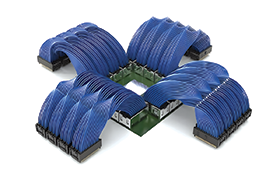

Developments of the last few years have thrust the subjects of artificial intelligence and machine learning into the limelight.
With the growth of online tools, consumers can now harness the power of AI for a range of tasks. High-performance interconnects provide the link between CPUs and AI accelerators and play a vital role in the scalability and flexibility that these systems demand.
Despite its recent place in the spotlight, AI has been with us for some time. AI powers the algorithms that navigate us through the world. It keeps traffic moving and recommends our next purchase, along with countless other tasks. In essence, these systems are crunching through enormous amount of data, making vast numbers of calculations, and analysing patterns to aid us in decision making.
Coping with larger models is at the heart of the AI revolution, and providing the computing power that is required is a challenge for designers. Fortunately, there is precedent in conventional computer design. The familiar desktop computer handles data-intensive tasks by handing off the processing required for specialist devices. The CPU is responsible for core tasks, but assigns graphics processing or sound emulation to secondary specialist modules. This has led to the structure that is familiar today – a graphics card and sound card, along with other specialist components, mounted to a CPU on a motherboard.
In the world of AI, accelerators perform a similar task. The CPU continues to provide the processing power for the overall system, whilst accelerators, often GPUs, are the specialist hardware, providing the dedicated computational power to crunch through the large models being used by the latest AI systems. The key difference between a conventional computer with its single accelerator or GPU is scalability.
Instead of a one-to-one relationship of CPU to accelerator card, it is possible to equip a single CPU with a potentially large number of accelerators. In such an arrangement, efficient computation depends on the transmission of data between cards with the lowest possible latency and the greatest possible signal integrity. The connections between the cards therefore play a vital role in allowing these computers to process the data they need to.
A range of Samtec connectors are playing an enormous role in delivering the connectivity required by AI systems. The range includes conventional board-to-board connector systems that support industry-standard form factors, including PCIe CEM AIC and PECFF. However, faster data rates can be supported over longer distances using ultra-low-skew twinax cable to bypass high-loss printed circuit boards. Samtec’s AcceleRate HP cable assembly is the industry’s highest density 112 Gbps PAM4-rated solution for cable-to-board applications.
| Tel: | +27 11 425 1400 |
| Email: | [email protected] |
| www: | www.spectrumconcepts.co.za |
| Articles: | More information and articles about Spectrum Concepts |
© Technews Publishing (Pty) Ltd | All Rights Reserved